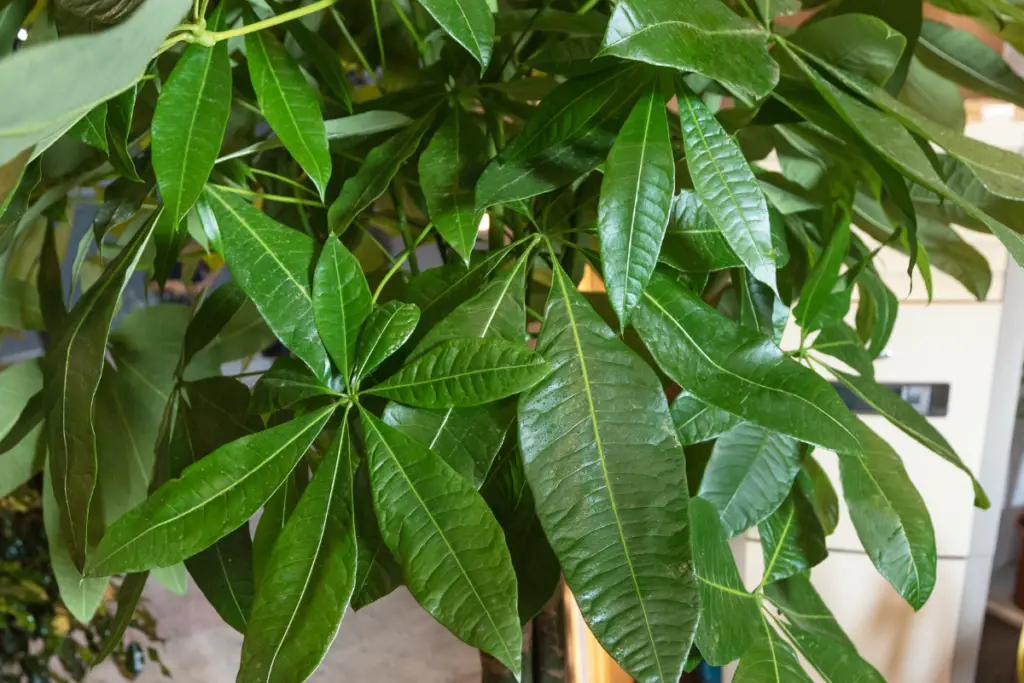Money trees are popular houseplants that are believed to bring good fortune and prosperity to their owners.
These plants are easy to care for and can thrive in most indoor environments. However, proper watering is crucial to ensure the health and longevity of your money tree.
When it comes to watering a money tree, the best rule of thumb is to water only when the top inch or two of soil is completely dry.
This can be checked by sticking your finger into the soil about an inch down. If it feels dry, it is definitely time to water.
Overwatering can lead to root rot and other issues, so it’s important to avoid watering too frequently.

Table of Contents
Understanding The Money Tree
Money Trees (Pachira aquatica) are tropical plants native to Central and South America. They are popular houseplants due to their attractive appearance and low maintenance requirements.
The Money Tree is known for its distinctive braided trunk and shiny green leaves. It can grow up to 60 feet tall in the wild, but it usually grows to about 6 feet tall indoors.
Money Trees are easy to care for and can thrive in a variety of lighting conditions. They prefer bright, indirect light but can tolerate lower light levels.
Direct sunlight can scorch the leaves, so it’s best to keep them away from windows that receive direct sunlight.
The Money Tree is a hardy plant that can tolerate a range of temperatures. It prefers temperatures between 65-75°F (18-24°C) but can tolerate temperatures as low as 50°F (10°C) and as high as 90°F (32°C).
It’s important to keep the plant away from drafty areas and air conditioning vents, as they can cause the leaves to dry out.
Money Trees prefer well-draining soil that is rich in organic matter. They are sensitive to overwatering, so it’s important to allow the soil to dry out slightly between waterings.
The frequency of watering will depend on several factors, including the size of the pot, the humidity of the environment, and the amount of light the plant receives.
In the next section, we will discuss how to water a Money Tree properly to ensure its health and longevity.
Importance Of Watering
Watering is one of the most critical aspects of money tree care. Proper watering ensures that the plant receives adequate moisture, which is essential for its growth and overall health.
Money trees are native to humid environments, and they thrive in moist soil. However, overwatering can be just as harmful as underwatering.
It is crucial to strike a balance between the two to avoid root rot, which can kill the plant.
Underwatering can lead to dry soil, which can cause the leaves to wilt and turn yellow. If the soil is too dry, the plant may drop its leaves, and the stems may become brittle.
On the other hand, overwatering can lead to waterlogged soil, which can cause the roots to rot. The leaves may turn brown or yellow, and the plant may develop a foul odor.
To avoid these problems, it is essential to water money trees correctly. It is recommended to water the plant when the top inch of soil feels dry to the touch.
When watering, it is crucial to ensure that the water reaches the plant’s roots. It is best to water the plant thoroughly until the water runs out of the pot’s drainage hole.
This ensures that the roots receive adequate moisture without leaving excess water in the soil.
It is also important to avoid letting the plant sit in standing water, as this can cause root rot. If excess water accumulates in the saucer, it is best to remove it promptly.
Overall, proper watering is crucial for the health and growth of money trees. With the right amount of moisture, these plants can thrive and bring joy to any indoor space.
When To Water Your Money Tree
Identifying Dry Soil
Money Trees should be watered no more than once a week, and only after the first inch of topsoil is dry.
It is important to water these trees thoroughly until the water runs out of the pot’s drainage hole. Money Trees should never be left in standing water.
Overwatering can lead to root rot, which can be fatal to the plant.
The simplest indicator that a Money Tree needs water comes from its soil. While it’s important to let a Money Tree dry between waterings, the soil should never feel parched.
While it shouldn’t be too dry, the plant’s soil mustn’t be sopping wet either. To check the moisture level of the soil, insert a finger into the soil up to the first knuckle.
If the soil feels dry at this depth, it’s time to water the plant.
Seasonal Watering Needs
The amount of water a Money Tree needs depends on the season. During the growing season, which is typically from spring to fall, Money Trees require more water.
In contrast, during the dormant season, which is usually from late fall to early spring, Money Trees require less water.
In addition to seasonal changes, the size of the pot and the amount of light the plant receives can affect how much water a Money Tree needs.
If a Money Tree is in a small pot or receives a lot of light, it may require more frequent watering.
It’s important to monitor the soil moisture level regularly to determine when to water a Money Tree. With proper care and attention, a Money Tree can thrive and bring good fortune to its owner.
How To Water Your Money Tree
Money trees are popular houseplants that require proper watering to thrive. Overwatering or underwatering can lead to various problems, such as root rot or leaf drop.
Here are two effective methods to water your money tree:
Soaking Method
The soaking method is a great way to ensure that your money tree gets enough water without drowning the roots. Here are the steps to follow:
- Fill a bucket or basin with water.
- Place the money tree pot in the water and let it soak for about 30 minutes.
- Remove the pot from the water and let it drain completely before placing it back in its saucer.
- Discard any excess water in the saucer to prevent root rot.
This method is particularly useful if your money tree has become very dry, as it allows the soil to absorb water slowly and thoroughly.
Spray Bottle Method
The spray bottle method is a good option if you want to give your money tree a quick drink or if you have a small plant that is difficult to soak. Here are the steps to follow:
- Fill a spray bottle with room-temperature water.
- Spray the water over the soil until it is moist but not saturated.
- Wait for the soil to dry out slightly before watering again.
- Avoid spraying the leaves directly, as this can cause water spots or damage.
This method is ideal for smaller money trees or for plants that need only a small amount of water at a time.
Remember that the frequency of watering your money tree will depend on various factors, such as the size of the plant, the type of soil, and the humidity levels in your home.
A good rule of thumb is to water your money tree only when the top inch or two of soil is dry to the touch.
You can also use a moisture meter to check the soil moisture level more accurately. By following these watering tips, you can help your money tree grow healthy and strong.
Common Mistakes To Avoid
When it comes to watering a money tree, there are a few common mistakes that people make that can harm the plant.
Here are some of the most important things to avoid:
Overwatering
One of the most common mistakes that people make when watering a money tree is overwatering.
Money trees prefer slightly moist soil, but they do not like to be constantly wet. Overwatering can lead to root rot, which is a serious problem that can kill the plant.
To avoid overwatering, it is important to let the soil dry out slightly between waterings. This will help ensure that the roots are not constantly wet and that the plant is not at risk of developing root rot.
Using Cold Water
Another mistake that people make when watering a money tree is using cold water. Money trees prefer slightly warm water, and using cold water can shock the plant and cause damage to the roots.
To avoid using cold water, it is recommended to let the water sit out for a few hours before using it to water the plant.
This will help the water come to room temperature and ensure that it is not too cold for the plant.
Ignoring Humidity
Finally, another mistake that people make when watering a money tree is ignoring humidity. Money trees prefer a humid environment, and low humidity can cause the leaves to dry out and turn brown.
To avoid low humidity, it is recommended to mist the leaves of the plant regularly or to use a humidifier in the room where the plant is located.
This will help ensure that the plant is in a humid environment and that the leaves stay healthy and green.
Maintaining Your Money Tree Post-Watering
After watering your money tree, there are a few important steps to follow to ensure it stays healthy and happy.
This section will cover two crucial post-watering maintenance steps for your money tree: drainage process and checking for diseases.
Drainage Process
Proper drainage is essential for the health of your money tree. After watering, make sure to empty any excess water from the saucer or pot tray.
Leaving water sitting in the tray can lead to root rot, which can be fatal for your plant.
If your money tree is in a pot without drainage holes, consider repotting it into a pot with drainage holes to prevent water from accumulating in the soil.
Additionally, make sure to use a well-draining soil mix that allows water to flow through easily.
Checking For Diseases
Regularly checking your money tree for signs of disease can help catch any issues early on and prevent them from spreading.
Some common signs of disease in money trees include yellowing leaves, leaf drop, and brown spots on the leaves.
If you notice any of these symptoms, inspect your plant closely for pests or fungal growth. Remove any affected leaves or branches and treat the plant with an appropriate fungicide or pesticide.
It’s also a good idea to isolate the affected plant from other plants to prevent the spread of disease.
Overall, proper post-watering maintenance is crucial for the health of your money tree. By following these simple steps, you can help ensure your plant stays happy and healthy for years to come.
Conclusion
Watering a money tree is a simple task that requires a bit of attention and care. The key to watering a money tree is to avoid overwatering, which can lead to root rot and other problems.
It is important to check the soil moisture levels regularly and water the plant only when the top inch or two of soil is completely dry.
Using room temperature, contaminant-free water is essential to the health of a money tree. It is best to use slightly acidic water with a pH between 6.0 and 7.0, and avoid using tap water if it has a high mineral content. Filtered water or rainwater are good alternatives.
One effective way to check the soil moisture levels is to stick your finger into the soil about an inch down.
If the soil feels dry, it is time to water the plant. Alternatively, you may want to purchase a small moisture meter to get a more precise reading.
In summary, watering a money tree is a straightforward task that requires some attention and care. By following the guidelines outlined in this article, anyone can keep their money tree healthy and thriving.
- How to Dry Basil Leaves: A Professional Guide
- Is an Avocado a Fruit or Vegetable? Simple Answer and Explanation
- Does Pineapple Have Seeds? Exploring the Anatomy of Pineapples
- Blooming Through Winter: Can I Grow Vegetables Indoors in the Winter?
- What Can You Grow in a Greenhouse All Year Round: A Guide to Year-Round Greenhouse Gardening
- Are Blueberries Blue? Debunking the Myth of Their Color
















